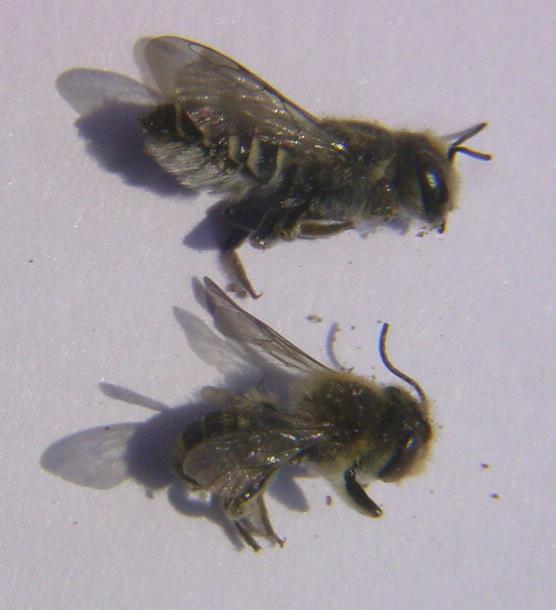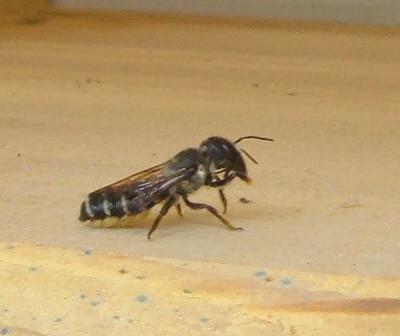
The alfalfa leafcutter bee belongs to the family Megachilidae. The Latin name refers to the large mandibles (jaws) of the bees in this group. Members of the Megachilidae family use their large, scissor-like mandibles to gather pieces of leaf, flower petals, mud, or plant resins for the construction of their nests. The genus, Megachile, includes bees that construct nests out of leaf pieces or flower petals—the leafcutter bees. There are about 115 species of leafcutter bees in North America, including both native and nonnative species (see sidebar).
The alfalfa leafcutter bee is smaller than many native leafcutter bees ranging from 1⁄4 to 3⁄8 inch (6.4 to 10 millimeters). Parallel rows of pollen collecting hairs located on the underside of the female bee’s abdomen, called the scopa, are silver or gray in color. Other female leafcutter bee species usually have black, tan, or yellow scopa. Female alfalfa leafcutter bees are larger than male bees, (Figure 7.3) with a few gray hairs around the face, and a stinger at the tip of their pointed abdomen. Despite having a stinger, female leafcutters are not aggressive, and rarely sting, even when handled. The sting is also much less painful than that of a honey bee. As a result beekeepers do not need any special protective equipment when working with leafcutter bees. Male bees have conspicuous green eyes, yellow hairs around the face, slightly longer antennae, and straight, non-tapered abdomens with no scopa or stinger.
All leafcutter bees are solitary, meaning that each female bee independently constructs her own nest, provisions the nest with pollen, and lays eggs. There is no queen, and the bees do not live together as a social unit like honey bees do. Female leafcutters do not interact with other bees or with their own offspring after laying their eggs. Alfalfa leafcutter bees are gregarious, however, meaning that they have a tendency to construct their nests near each other; hence large numbers of bees can be housed in a single structure containing multiple nests. Other leafcutter bee species will nest in manmade nests, however most species are difficult to manage because they are not gregarious. Male leafcutter bees have no role in the construction or the provisioning of nests. Upon their emergence as adults, male leafcutters mate one or more times and may live for several weeks, then die. While they may feed on small amounts of flower nectar to maintain their own energy, male bees do not actively collect pollen and have little value as pollinators.
The Sunflower Leafcutter Bee

In the early 1980s researchers at the USDA-ARS Bee Laboratory in Logan, Utah identified a second leafcutter bee with significant management potential.
Because of its affinity for flowers in the Compositae family, the native Megachile pugnata (Figure 7.2) was dubbed the “sunflower leafcutter bee.” Like the alfalfa leafcutter bee, M. pugnata nests gregariously in artificial nest blocks and has similar management requirements. Also like the alfalfa leafcutter, M. pugnata produces both single and second generation bees based on similar environmental factors.
Rather than lining nest tubes with leaf pieces like most other leafcutters, the sunflower leafcutter combines mud and leaf parts to form a pulp used to separate cells and plug nest entrances. This habit makes loose-cell management of the bee difficult. Instead closed-cell systems more similar to mason bee management are required. The sunflower leafcutter is also nearly twice as large as the alfalfa leafcutter, and requires correspondingly larger nests. In field trials on hybrid sunflower, M. pugnata has demonstrated excellent management potential. For instance, a study of pollination efficiency measured nearly one seed fertilized per second during flower visits by the bee. In comparison, honey bees average much lower at only 0.05 seeds per second!
Unfortunately little research on Megachile pugnata has been conducted, and no commercial suppliers exist (although wild populations are available in many areas). As with other bees, there are significant management challenges with the sunflower leafcutter including various parasites and chalkbrood; however, for the right person this bee could spark a whole new industry!
